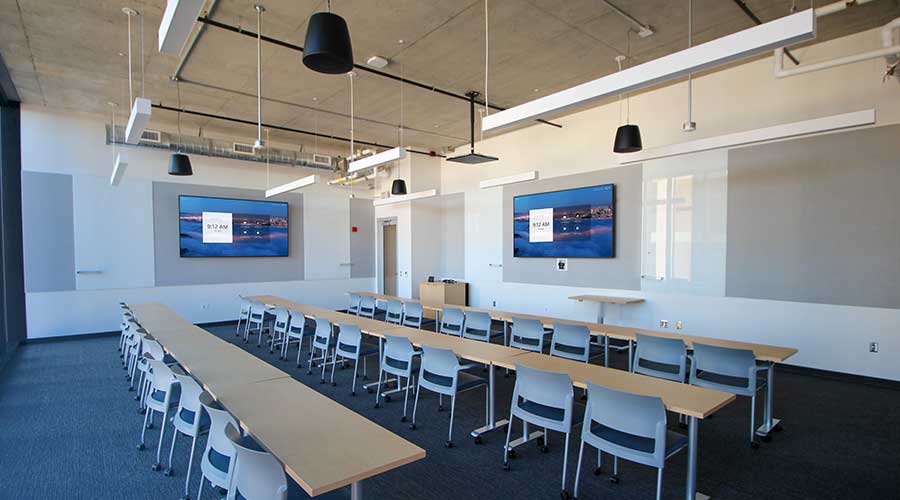
Give Remote Students a Front Row Seat to Better Learning
HOW TO GIVE REMOTE STUDENTS THE CLASSROOM EXPERIENCE
Distance learning and extension programs are excellent ways for higher education institutions to increase enrollment and reach without making large investments in new buildings, staff, and other infrastructure. But the colleges and universities that will benefit the most these programs are those that create a remote learning experience that is equal to that of the classroom. Here are three questions to help you determine whether remote students can participate to the same extent and in-classroom students—and here’s how to fix it if they can’t.
CAN YOUR REMOTE STUDENTS SHARE AND ACCESS CONTENT JUST LIKE EVERYONE ELSE?
There are plenty of classroom tools that help professors and students share content with each other, but what about remote students? Can they see what is being shared in the classroom and share their own content as well? There are collaboration and content sharing platforms that allow remote students to share with those in the classroom, providing distance learners with the same experience as their on-site peers. Software and apps that allow students to share from their personal devices create yet a more intuitive and equal experience.
CAN YOUR DISTANCE LEARNERS HEAR EVERYTHING HAPPENING IN THE ROOM?
Many remote workers report feeling left out, and the same threat of feeling excluded or not part of the team exists for remote students as well. Poor audio in the classroom can easily exacerbate the issue. Imagine how frustrating it would be to hear the class erupt into laughter, but not have heard the joke. Or to hear the professor say, “You can use that on the test” only to realize you missed the hint. Clear audio is key to equalizing the experience for in-class and remote students. If distance learners can’t hear everything that on-site students can, then they are having an inferior experience and are likely at a disadvantage when it comes time to work on projects or take exams. Your first instinct to address an audio disparity might be to increase the number of microphones around the room, and that’s not a bad place to start. But improving the quality of your microphone technology will do more to improve the audio experience for both in-person and remote students. For example, beamforming microphones are designed to be more sensitive to sound coming from one or more specific directions of the classroom. Using beamforming microphones, like the newest edition to ClearOne’s offerings —the Beamforming Microphone Array Ceiling Tile, increases the coverage of the entire classroom with each microphone picking up the sound closest to it.
CAN YOUR REMOTE STUDENTS SEE WHO IS SPEAKING FROM ANYWHERE IN THE ROOM?
Classroom cameras often have the same downfall as classroom audio solutions—they don’t capture everything. Many classrooms have just one camera view, usually focused on the front of the room where the instructor is. Remote students can’t see who is speaking in the corner, the back of the room, or otherwise off-camera. That leaves remote students feeling like they’re being left out and not getting the same experience as their peers in the classroom. Placing multiple cameras around the room can easily fix this problem, and a video switcher can help you move between multiple camera views so remote students can see everything in-room students can. A manual video switcher is a more budget-friendly option. When students want to talk, they press a button at their desk or table and the camera mounted at the front of the room will zoom in on the speaker. If you have a little more money in your budget, you might consider an automatic video switcher. In some models, the presenter wears an infrared lanyard that can be tracked by the camera as the presenter moves around the room. Another option is a presence-sensing mat that triggers the camera when the presenter steps on it. Ceiling mounted infrared sensors can also trigger cameras to focus on a certain area of the room.
Next Steps
According to the National Center for Education Statistics, a quarter of all college students took at least one online class in 2015, the most recent year for which data is available. And just over 12 percent of college students took online courses exclusively that same year. Colleges and universities that aren’t equipped to provide remote students with a high-quality educational experience—equal to the in-classroom experience—will find themselves missing out on an increasingly significant segment of prospective students.
The solution? Working with a qualified AV integrator to design a comprehensive and integrated system that delivers for all your learners, no matter where they are. To get started, reach out to us here or click the chatbox below to connect instantly. We look forward to working with you.

